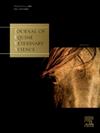“热舒适和种马繁殖中的种子性状:理解这些关系的新方法”。
IF 1.6
3区 农林科学
Q2 VETERINARY SCIENCES
引用次数: 0
摘要
背景:种马育种主要是基于理想的表型性状,很少考虑精液质量。目的/目的:利用非侵入性的综合方法确定夏季和冬季种马精液参数之间的关系。方法:对24匹公马进行冬季(穿大衣)和夏季(穿t恤衫)的精液采集、睾丸热像仪和多普勒超声睾丸动脉速度测量,以及生理、环境和热应激参数的测量。统计测试包括单变量和多变量分析软件SPSS®(IBM)。结果:精子缺陷(22.4 ± 7.3%)和热应激指数(THI: 79.7 ± 3.4;夏季(28.6 ± 2.7 °C)高于冬季(12.5 ± 9.4%); 21.1±2.4 °C;THI: 73.5 ± 8.6; ThStress: 1.1±0.3 )。热应力指数计算公式为THI= [0.8 x (EnTemp + RH/100)] x [(EnTemp - 14.4) + 46.4]。相比之下,冬季睾丸收缩/舒张期血流速度、运动性和活力更大(33.3 ± 9.3 cm/s; 5.9± 2.2厘米/秒; 81.2± 8.5%;3.2 ± 0.4)高于夏季(24.4 ± 6.7 cm/s); 4.0± 1.0厘米/秒; 64.2± 21%; 2.7±0.6 )。夏季热舒适指数与精液性状显著相关,冬季多普勒/热成像数据与精液质量显著相关。结论:所分析的指标表征了种马的热、循环和精液参数,突出了季节差异和相关性,支持多普勒超声和红外热像仪在育性评估、热舒适和最佳繁殖季节选择方面的应用。本文章由计算机程序翻译,如有差异,请以英文原文为准。
Thermal comfort and seminal traits in stallion reproduction: New methods to understand these relationships
Background
Stallion breeding is mostly based on desirable phenotypic traits, with little consideration for semen quality.
Aims/objectives
To identify relationships among semen parameters in stallions using a non-invasive, integrative approach across summer and winter seasons.
Methods
Twenty-four stallions were evaluated, in which semen collections, testicular thermography, and Doppler velocimetry of the testicular artery by Doppler ultrasonography were performed, in addition to the measurement of physiological, environmental, and heat stress parameters, both in winter (coat weather) and summer (T-shirt weather). Statistical tests included univariate and multivariate analyses in software SPSS® (IBM).
Results
Sperm defects (22.4 ± 7.3 %) and heat stress indices (THI: 79.7 ± 3.4; ThStress: 2.9 ± 0.7) were higher in summer (28.6 ± 2.7 °C) than in winter (12.5 ± 9.4 %; 21.1 ± 2.4 °C; THI: 73.5 ± 8.6; ThStress: 1.1 ± 0.3). The heat stress indices were calculated by the equation: THI= [0.8 x (EnTemp + RH/100)] x [(EnTemp – 14.4) + 46.4]. In contrast, systolic/diastolic testicular blood flow velocities, motility, and vigor were greater in winter (33.3 ± 9.3 cm/s; 5.9 ± 2.2 cm/s; 81.2 ± 8.5 %; 3.2 ± 0.4) than in summer (24.4 ± 6.7 cm/s; 4.0 ± 1.0 cm/s; 64.2 ± 21 %; 2.7 ± 0.6). Significant correlations were found between thermal comfort indices and seminal traits in summer, and between Doppler/thermographic data and semen quality in winter.
Conclusion
The analyzed indices characterized thermal, circulatory, and seminal parameters in stallions, highlighting seasonal differences and correlations, and supporting the use of Doppler ultrasonography and infrared thermography in fertility assessment, thermal comfort, and optimal breeding season selection.
求助全文
通过发布文献求助,成功后即可免费获取论文全文。
去求助
来源期刊

Journal of Equine Veterinary Science
农林科学-兽医学
CiteScore
2.70
自引率
7.70%
发文量
249
审稿时长
77 days
期刊介绍:
Journal of Equine Veterinary Science (JEVS) is an international publication designed for the practicing equine veterinarian, equine researcher, and other equine health care specialist. Published monthly, each issue of JEVS includes original research, reviews, case reports, short communications, and clinical techniques from leaders in the equine veterinary field, covering such topics as laminitis, reproduction, infectious disease, parasitology, behavior, podology, internal medicine, surgery and nutrition.
 求助内容:
求助内容: 应助结果提醒方式:
应助结果提醒方式:


